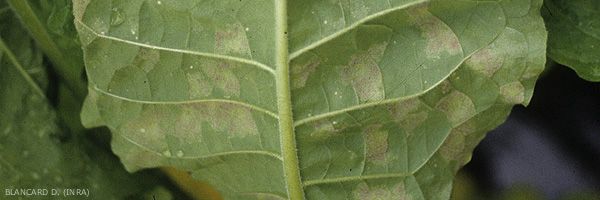
Peronospora hyoscyami f. sp. tabacina
Skalický (1964)
Blue mould
- synonym : Peronospora tabacina D.B. Adam (1933)
- English names : Blue mould, Downy mildew ; Spanish name : mildiù del tabaco
Tobacco blue mould, caused by Peronospora hyoscyami f.sp. tabacina, is one of the most dreaded diseases affecting tobacco. It has been a devastating disease in the past and could be again. Blue mould can cause severe losses up to destroying entire crops in a few days if weather conditions are favourable. It does not occur in all tobacco producing areas.
Countries where blue mould does not occur are China, Japan, Zimbabwe, Malawi, South Africa, and India. In some other countries, the disease presents certain peculiarities:
- it attacks only nurseries in Brazil, Argentina, Paraguay and Mali. In the USA blue mould caused widespread losses from 1979 to 1980. During those years, the disease occurred in fields as well as in plant beds. The fungus also spreads when infected seedlings are shipped. Its occurrence was sporadic until 1995, when it became widespread again. Since mid 2000s only a few outbreaks have been reported. Overall the disease is considered a more serious problem in the Burley rather than the flue-cured production areas of USA with most cases reported in fields rather than greenhouses.
- in some countries there are pathogen strains resistant to metalaxyl, an issue that raises questions about the effectiveness of chemical control (Mexico, Cuba, Nicaragua, Honduras, and the USA).
This disease leads to so called continental epidemics. The reservoir for inoculum in Europe seems to be in one or several Mediterranean countries. All production areas in Europe are affected. The incidence of the disease may differ between countries. This difference might be explained by management practices such as the use of resistant varieties, the existence of diverse weather patterns, and the implementation of more or less effective control strategies. For the past several years, blue mould has been relatively well controlled in France. The few cases encountered each year are associated with poor chemical control. Infections occur mostly in the nurseries and/or rather late in the field.





